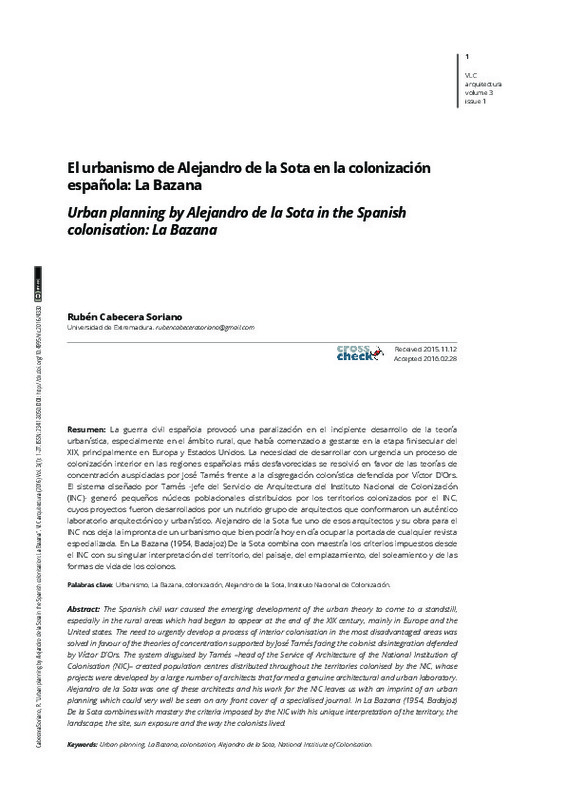|
Resumen:
|
[EN] La guerra civil española provocó una paralización en el incipiente desarrollo de la teoría
urbanística, especialmente en el ámbito rural, que había comenzado a gestarse en la etapa finisecular del
XIX, principalmente ...[+]
[EN] La guerra civil española provocó una paralización en el incipiente desarrollo de la teoría
urbanística, especialmente en el ámbito rural, que había comenzado a gestarse en la etapa finisecular del
XIX, principalmente en Europa y Estados Unidos. La necesidad de desarrollar con urgencia un proceso de
colonización interior en las regiones españolas más desfavorecidas se resolvió en favor de las teorías de
concentración auspiciadas por José Tamés frente a la disgregación colonística defendida por Víctor D’Ors.
El sistema diseñado por Tamés -Jefe del Servicio de Arquitectura del Instituto Nacional de Colonización
(INC)- generó pequeños núcleos poblacionales distribuidos por los territorios colonizados por el INC,
cuyos proyectos fueron desarrollados por un nutrido grupo de arquitectos que conformaron un auténtico
laboratorio arquitectónico y urbanístico. Alejandro de la Sota fue uno de esos arquitectos y su obra para el
INC nos deja la impronta de un urbanismo que bien podría hoy en día ocupar la portada de cualquier revista
especializada. En La Bazana (1954, Badajoz) De la Sota combina con maestría los criterios impuestos desde
el INC con su singular interpretación del territorio, del paisaje, del emplazamiento, del soleamiento y de las
formas de vida de los colonos.
[-]
[EN] The Spanish civil war caused the emerging development of the urban theory to come to a standstill, especially in the rural areas which had began to appear at the end of the XIX century, mainly in Europe and the United ...[+]
[EN] The Spanish civil war caused the emerging development of the urban theory to come to a standstill, especially in the rural areas which had began to appear at the end of the XIX century, mainly in Europe and the United states. The need to urgently develop a process of interior colonisation in the most disadvantaged areas was solved in favour of the theories of concentration supported by José Tamés facing the colonist disintegration defended by Víctor D’Ors. The system disguised by Tamés –head of the Service of Architecture of the National Institution of Colonisation (NIC)– created population centres distributed throughout the territories colonised by the NIC, whose projects were developed by a large number of architects that formed a genuine architectural and urban laboratory. Alejandro de la Sota was one of these architects and his work for the NIC leaves us with an imprint of an urban planning which could very well be seen on any front cover of a specialised journal. In La Bazana (1954, Badajoz) De la Sota combines with mastery the criteria imposed by the NIC with his unique interpretation of the territory, the landscape, the site, sun exposure and the way the colonists lived.
[-]
|








